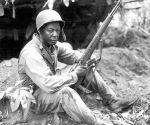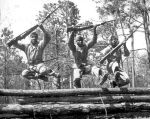African-American Soldiers of the Pacific War – Intermission Story (16)
MacArthur was one of the few theater commanders who welcomed black troops into his command. However, “colored” units in the Pacific were almost never employed in a combat role. One exception was 93rd Division. Despite the skepticism of many senior commanders, the division had performed satisfactorily in training and in the Texas-Louisiana maneuvers of 1943. The 93 Division was ordered to Hawaii in December 1943 , in order to free a white division for combat. However, its orders were changed almost at once to send the division to New Georgia.
From Munda a single battalion from the division, 1/24th Regiment was deployed to the Bougainville perimeter in January 1944, and elements of the battalion reached the front line in March. For the most part, the battalion performed well in combat, but on 6 April a single inexperienced company from the battalion panicked when it came under fire during a routine patrol. Discipline broke down, troops from one platoon mistakenly fired on another platoon, and the company returned to the perimeter in considerable disorder. Such conduct was hardly unknown among inexperienced soldiers of any race, but the mistakes and confusion among the black troops was widely reported in the media, and rumor inflated the failure of a single company into an impression of poor performance by the entire division. 93 Division saw very little combat thereafter.
Most black troops in the Pacific were employed as service troops. These were certainly needed and made an invaluable contribution to ultimate victory. About a third of the troops working on the Alaska-Canada Highway and the Burma Road were black. Other blacks served in amphibious tractor battalions.
In 1942, there was a mutiny at Townsville by African-American troops of 96 Engineer Battalion, who responded to abuse by two white officers by machine gunning the officers’ tents. At least one officer was killed and several others wounded, and Australian troops had to be called in to put down the riot. Future president Lyndon B. Johnson visited the base for three days, apparently to defuse the situation. The mutiny was subsequently covered up and did not come to light for seventy years.
The Navy had been largely integrated, at least among its enlisted men and petty officers, until the First World War. The Wilson administration adopted policies that all but excluded blacks from the Navy, even replacing black mess stewards with Filipinos. It was not until the 1930s that blacks began to be quietly recruited into the Navy again. Though most served as mess specialists, there are no noncombatants on a warship, and segregation is difficult to enforce. Black sailors eventually won grudging respect from their white crew mates, opening the door a little wider to eventual desegregation of the armed forces.
The Marines were very reluctant to accept black recruits. However, once the necessity was forced on them, they quickly adapted. A black Marine was still a Marine. Although attempts were made to restrict black Marines to defense battalions and support services, black ammunition carriers served with distinction under fire at Saipan and began appearing in the front lines at Peliliu. (Sloan 2005):
As the men of the supply unit picked up their weapons and fell into line behind their sergeant, Mulford tried to discourage them. “Nothing you people have seen this beach is gonna prepare you for the hell you’re gonna face if you go with us,” he said. “So don’t say I didn’t warn you.”
“We can take it,” the black sergeant assured him.
For the rest of the day, the African-American Marines made dozens of trips between the front lines and rear areas. They carried dead and wounded in one direction and hauled back ammo, food, and other supplies on their return trips. That night, they moved into vacant foxholes along the line and helped fight off a Japanese counterattack. The next morning, in several hours of bloody fighting, they charged and took an enemy-held hill shoulder to shoulder with what was left of I Company.
A formation of black Marines, 8 Field Depot, helped turn back the final Japanese counterattack on Iwo Jima on 4 April 1945. Regrettably, the Marines would revert to a heavily discriminatory racial policy after the war.
Information from: The Pacific War online. Pictures from: The History Place
Click on images to enlarge.
#####################################################################################
I live in Florida, as many of you know, and could possibly be in the path of Hurricane Irma. I fully expect to lose power at some point. PLEASE be patient and I will eventually return to catch up on your posts and answer questions and reply to comments.
Do NOT feel obligated to respond to this Shout Out, it is merely an informative reminder.
Thank You.
#####################################################################################
Military Humor –
#####################################################################################
Farewell Salutes –
Brian Aldiss – Dereham, ENG; British Army, WWII, CBI, Royal Signals, (author)
Martin ‘Butch’ Beechler – Palm Beach Gardens, FL; US Army, Vietnam, 31st Infantry
Meredith Cooper – Linton, IN; US Air Force, Korea
Harold Evans – Spokane, WA; US Army Air Corps, WWII, PTO, E/188th/11th Airborne Division
Dick Gregory – St. Louis, MO; US Army, (comedian)
James Johnson – Glendale, CA; US Navy, pilot (Ret. 22 yrs.)
Adrian Marcuse – Glen Cove, NY; US Army Air Corps, WWII, PTO, 18th/13th Air Force
Jeannie Rousseau – Saint-Brieuc, FRA; Allied Agent, WWII, ETO, POW
Gordon Thompson – Moccasin, MT; USMC, WWII, PTO, “Cactus Air Force”, LT. pilot, KIA
John Winner – MD; US Army, Korea
#####################################################################################
Posted on September 7, 2017, in Uncategorized, WWII and tagged 1940's, History, Military, Military History, Pacific War, PTO, Tributes, USA, veterans, WW2, WWII. Bookmark the permalink. 198 Comments.
















A most interesting post. While I knew that Filipino guerrillas were relegated in most instances to support roles in the waning days of WWII (except for USAFIP-NL), I did not fully realize and appreciate the role played by African-Americans.
LikeLiked by 2 people
My father even said in some instances, the African-American soldier was so alien to the Japanese, they were frightened of them too.
LikeLiked by 1 person
A balanced and informative post. Thank you, GP. Much appreciate this.
LikeLiked by 1 person
Glad you found it interesting, Eric. In a Blog-world filled with authors, this amateur appreciates the encouragement! 🙂
LikeLiked by 2 people
Fascinating account. I used to teach this topic to High School kids. There was a lot here that I didnt know. Thank you.
LikeLiked by 1 person
My pleasure. I understand history is not being treated as such a major subject any more. True?
LikeLiked by 1 person
It depends – in England you need History to qualify for what they call the English Bacc. So schools are keen that pupils take an exam in it. In Wales, where I used to teach, you don’t. So, many heads have used it as an excuse to cut teaching hours and cut staff. Until these changes were made, History was a very popular examination subject. Modern World History (esp C20th US History) was particularly popular with kids. However, the exam boards (as told by the English government) have recently made a lot of changes to the exams to make them more content heavy (and lots more British History) and harder to get good grades – so that will put kids off taking the course. Which, is a shame as I always found that kids were VERY interested in the past, especially if it was relatively recent.
LikeLiked by 2 people
Thank you for your reply and information, Emma!
LikeLiked by 1 person
I have to tweet this. It’s important.
LikeLike
Allan, all the stories of that generation should be important to us. That was a different world back, but we can learn from it, not try to erase it and not live it. I thank you for stopping by and finding the article interesting.
LikeLiked by 1 person
Fine to read about them because i know nothing of them
LikeLiked by 1 person
Thank you for taking the time, Mary Lou!!
LikeLike
Wonderful post about the African American Marines in the Pacific. So glad to learn that you’re alright in the aftermath of Irma. I, too, thought you lived in NJ. Stay safe and good luck with the recovery.
LikeLiked by 1 person
Thanks! No, I’m afraid I don’t know much about NJ except staying in Atlantic City for a few days when I was a kid.
LikeLike
Good to learn more about the African American history in the services.
LikeLiked by 2 people
So few know they were even in the Pacific!
LikeLiked by 1 person
I cannot imagine what it must have been like to have been a minority before (and really during) integration. War is terrible enough. Adding discrimination would make it so much worse.
So glad that Irma wasn’t too rough on you.
Irma and Harvey have caused so much distruction and misery.
LikeLiked by 1 person
I’m glad you found the post interesting.
The hurricanes I take it are Mother Nature’s way of getting even with us!!
LikeLiked by 1 person
Agree! She definitely let’s us know when the Earth is hurting
LikeLiked by 1 person
I suppose she feels it’s time we pay the piper!
LikeLike
Excellent article – sometimes it’s difficult to put yourself in the mindset of previous times.
LikeLiked by 2 people
Trying to see everyone’s different perspective puts it all in a different light. I’m glad you found it interesting.
LikeLiked by 1 person
You are to be congratulated on putting the facts forward with sufficient commentary, but without the hindsight of the 21st century. A difficult job well done.
LikeLiked by 1 person
Thank you. It was a different world back then, despite what the Millennials try to do to erase it!!
LikeLiked by 1 person
🙂
LikeLiked by 1 person
How are you holding up from Irma.? You’ve been in my thoughts. ❤️
LikeLiked by 1 person
I thank you for your concern, Mrs. P!! We didn’t get hit near as badly as Texas. I just received power again, so I am fully enjoying the AC!!!!
LikeLike
Me too! 😁
LikeLiked by 1 person
Very informative.Thanks.
LikeLiked by 1 person
Glad you found it interesting.
LikeLike
Nice post!!:D
By the way, do you live in Taxas??Hurricane???
If you have any help,please tell me!!
Hmmmm,How is you,Now?
LikeLiked by 1 person
I’m in Florida and we recently had Hurricane Irma, but did not have things as bad as Texas did!! I only just got electric power back, so all is well now!! Thank you so much for your concern, Nasuko.
LikeLiked by 1 person
I’m glad you’re OK :D.
Please let me know if there is anything I can do for you!!
LikeLiked by 1 person
I greatly appreciate your concern, but we are fine. Thank you.
LikeLiked by 1 person
I had no idea you were in Florida, figured you were a New Jersey boy. Hope you’re alright mate.
LikeLiked by 1 person
My better-half is New Jersey – I’m originally New York, but lived here for 47 years. We came through ok. I appreciate your concern.
LikeLiked by 1 person
I’m glad to hear you’re alright.
LikeLiked by 1 person
Thank you, Lloyd, I appreciate that.
LikeLiked by 1 person
Thank you for sharing the story.
LikeLike
Pingback: African-American Soldiers of the Pacific War – Intermission Story (16) — Pacific Paratrooper – Sporting Jazz Music